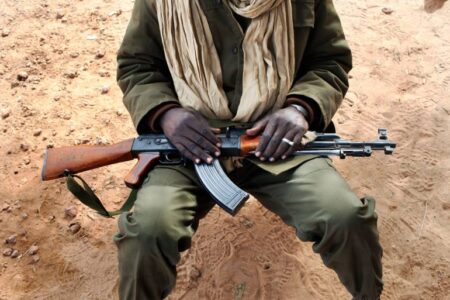
Islamic State documents implementation of Sharia law in northern Mali
On May 20, the Islamic State released photos within its weekly Al-Naba newsletter purporting to show its men enacting hudud punishments [or punishments mandated within Sharia law] on three alleged thieves in northern Mali.
According to the Islamic State, its local men, colloquially known as the Islamic State in the Greater Sahara (ISGS), rounded up the three accused bandits in the local market of Tin-Hama in Mali’s northern Gao region. The photos show the scene in Tin-Hama’s market prior to the amputations.
The men were reportedly arrested by ISGS during a robbery attempt on a local road in late April. According to the UN, which denounced the action, the actual amputation event took place on May 2.
The Islamic State’s editorial goes further and adds that it tried the men in its local Islamic courts and found them guilty of hirabah [a category of crimes under Sharia that includes banditry or highway robbery] and subsequently amputated limbs from each man.
The photos released by the Islamic State offer a rare glimpse into jihadist governance in the Sahel. Moreover, they detail both the jihadist group’s comfortability and capacity to operate openly in that part of northern Mali.
The Malian state is largely absent in rural Gao, including Tin-Hama, and local security has predominantly been the role of several militias and France’s Operation Barkhane.
It is clear that the Islamic State’s influence remains strong in the area; though this has been contested by al Qaeda’s Group for Support of Islam and Muslims (JNIM).
Al Qaeda and its allies previously controlled significant swaths of northern Mali for much of 2012 before being ousted by a French-led intervention in 2013. In recent years, however, jihadists loyal to both al Qaeda and the Islamic State, have wielded both direct and indirect control in many rural areas of the Sahel.
For instance, both ISGS and JNIM have been able to levy taxes, mandated zakat payments, organize local Sharia courts, offer protection from cattle rustling, and regulate usage of pastures across various communities in Mali, Burkina Faso, and Niger.
These events, however, are rarely publicized. The Islamic State’s photos thus demonstrate and serve as a reminder that while jihadists do not physically hold territory to the same scale as they did in 2012, they are still able to enact their strict forms of governance across a significant swath of the Sahel.
Source: Long War Journal





